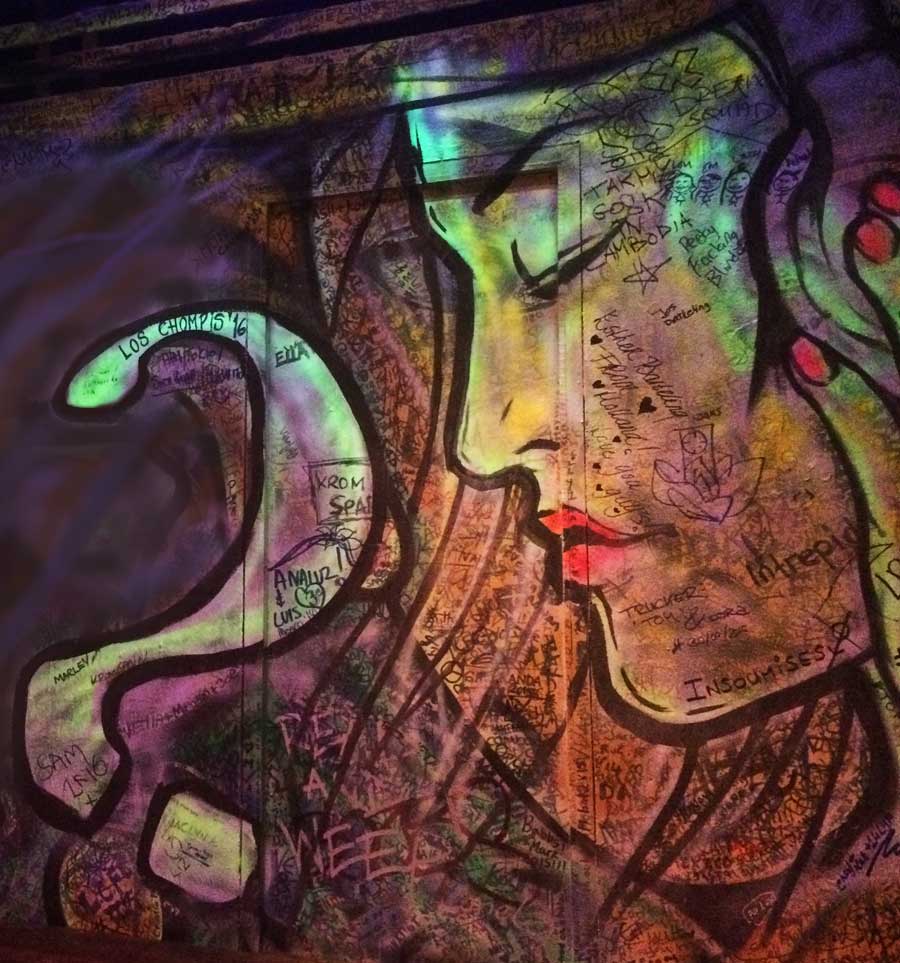SYNCHRONICITY ITSELF
Chapter 3
Meaning in the Middle
We humans are meaning-seeking creatures. We name, categorize, and assign meanings to everything we see. Even the words we speak serve as little carriers of meaning, helping us to communicate with each other and make sense of the world. But with synchronicity, the meaningful connections that we notice are different from the meanings that we assign to everyday objects and events because a synchronistic event involves content that is shared between the inner and outer worlds. It is the act of recognizing this connection through meaning—meaning that transcends the inner-outer boundary, inexplicably—that makes the event extraordinary and therefore meaningful.
This is all fairly clear in theory, but sometimes the meaningful connections that we see when we actually encounter synchronicity are not so straightforward. There can also be multiple meanings, buried meanings, and meanings that seem to have a higher intent behind them. Plus, for our purposes here, we still need to explore the core issue of what constitutes a meaningful connection.
Admittedly, there is a lot to sort though here, so let’s begin with a few case-examples to illustrate some of the ambiguity we can run into when it comes to the “meaningful connection” in synchronicity. Our first case, offered by Vaughn (1979) and paraphrased below, shows how an event can be meaningful and appear synchronistic even though the psychological component is unknown or uncertain.

Graffiti wall in Siem Reap, Cambodia
Returning the Favor:
One day while on duty on his motorcycle, patrolman Falby collided into the back of a truck and severely injured his leg. Ultimately, he would have bled to death if it wasn’t for businessman, Al Smith, who stopped to help him and used a necktie as a tourniquet to stop the bleeding. Oddly enough, the two men swapped roles five years later when Smith suffered a severe leg injury in a car accident, and it was Falby who arrived on the scene and applied the tourniquet.
This incident is so uncanny that you would think it was a clear-cut case of synchronicity. But then, where is the psychological component in this equation? Is it possible that Falby had been carrying a deep sense of gratitude and indebtedness toward Smith in the years following his motorcycle accident, and these feelings eventually conjured a second event that would allow Falby to balance the scales? This certainly seems plausible, especially for those who believe in karma. But of course, this is highly speculative, and this is one of the main pitfalls when it comes synchronicity interpretation. That is to say, when certain factors are missing or unclear, it is a natural tendency to try to fill in the gaps though speculation.
Our next case-example, offered by Faulk (1981) and paraphrased below, illustrates how a synchronistic event can acquire meaning largely though its auspicious and inexplicable nature.
Flammarion’s Wind:
One afternoon, while writing a chapter on the force of the wind for his book, “L’Atmosphere”, French scientist and author, Camille Flammarion (1846-1936), had his papers swept up and carried off by a whirlwind. Fortunately, the flyng pages found their way onto a nearby street which was frequented by the publisher’s porter, who often carried Flammarion’s work. Seeing that the pages were Flammarion’s, the porter gathered them up and brought them immediately to the publisher, who then returned them to their rightful and very appreciative owner.
In this case, there is a clear and intruiguing parallel between Flammarion’s research on wind activity and the rise of the whirlwind. The true irony, though, lies in the way the papers found their way home, almost immediately. Is it possible that Flammarion’s research was protected by something unseen, like a guardian angel? Let’s imagine for a moment that the pages just blew away and scattered throughout the city, never to return. If it had happened that way, most likely the thematic parallel between the whirlwind nd the manuscript would have been dismissed as an unfortunate fluke and that would have been the end of it. But instead, the manuscript mysteriously and expeditiously returned, and it is the unlikely odds of this hppening that raises the question of whether something larger or even divine might have been behind it. Here again, we see how all kinds of speculation and ambiguity can surround synchronistic events, especially when we try to determine the hows and whys. Sometimes, too, a string of peculiar events will appear to be thematically and symbolically connected even though the overall meaning is uncertain, as the case below demonstates:
Carlton and the Goldfish:
(offered by K. Eagon)
Carlton’s life was turned upside down after his teenage daughter ran away from home. She was gone for nearly a year, and it was a very difficult and emotionally-charged time for both of them. But she did return eventually, and about a week later, she gave Carlton two goldfish which he promptly put in his fish tank. That night as he slept, Carlton dreamt that the fish changed colors, one turning white and the other black. He also dreamt that they battled and one of them died and floated to the surface. Carlton was shaken by this dream, and when he checked the tank the next morning, sure enough, he found a dead white fish at the top. Then later that evening while watching the movie, “Bennie and June”, Carlton was struck by a particular scene in which the young female character, June, gave Bennie two fish which she named Steve and Stevens. Ironically, Steven was Carlton’s birth name and his daughter’s name was June. Then, if that wasn’t enough, Carlton was told an oddly relvant joke by a friend the next day. The friend asked him, “How many Texans does it take to roller blade?” Carlton said, “I don’t know.” The friend replied, “FISH!” Carlton said, “That doesn’t make sense.” The friend replied, “It’s not supposed to.”

New Zealand goldfish
[watercolor by R.D. Williams]
So what are we to make of this convoluted fish tale? On the surface, we can see that there is a synchronistic parallel between Carlton’s dream and the activities in the fish tank. But why? Is it possible that the goldfish in the tank and the fish in Carlton’s dream were symbolizing a battle in his mind, and that the odd coincidences that followed were simply adding emphasis to it? Then again, isn’t it also possible that this was just a string of peculiar coincidences, joined together by themes and names, and nothing more? Perhaps, but then there’s that punchline at the end—“It’s not supposed to make sense!”—which seems oddly intentional, as if to sum up the whole experience while also adding one last dose of confusion to it. This case reveals quite clearly how a brush with synchronicity can sometimes leave a person replaying the experience in their mind and wondering what it all means.
What exactly makes a “meaningful connection” meaningful? This question is an important one, but it’s not easy to answer because meaning is a subjective element and it is something that we determine individually based upon our lives and past experience. But then, if the meaningful connection that is identified in synchronicity is left soley to individual interpretation, what is to prevent anyone from liberally assigning meanings to events that are actually just coincidences? Fordham (1957) explains how he ran into this problem with a male client in his psychotherapy practice. The client had apparently resolved an important issue in his life thanks to a synchronistic experience, and as a result, he started seeing synchronicities everywhere. Said Fordham, even something like seeing two people wearing a similar hat would look suspiciously synchronistic to him.
Clearly, if we don’t define or at least put some perameters around the term meaningful, we can end up misinterpreting events and welcoming in all kinds of superstitous thinking. As Jung (1960) states: “…there is a danger that meaning will be read into things where actually there is nothing of the sort.” But then this begs the all-important question: how do we read the meaning of a synchronistic experience without reading meaning into it? This may sound a bit like a Zen koan, and perhaps it is somewhat, but let’s parse this out as best we can. Whenever we read meaning into something, we are basically inserting a meaning that does not necessarily belong there. What’s more, this imposed meaning will often involve a projection of ourselves (our thoughts, fears, wishes, imaginings, etc.) onto the situation. By contrast, the process of seeing meaning tends to happen on its own, more organically. As such, one of the best ways to guard against reading too much into synchronicity is to stand back from the experience and examine how the meaning arose in the first place. There are exceptions to this of course, particularly when buried meanings are involved—but in most cases, the meaningful connection should be fairly easy to spot and should seem to emerge from the experience itself, independently. Indeed, as a general rule of thumb, when it comes to that highly subjective element that we call “meaning”, in most instances of synchronicity: You will know it when you see it.
Qualities that Lend Meaning
Jung outlined four general ways by which synchronicity acquires its meaningful quality:
- Mirroring effect
- Numinosity
- Personal significance
- Inexplicability
The first form, mirroring effect, occurs when something in life appears to have direct correlation to something in one’s mind, creating the sense that the outer world is mirroring one’s psyche. When this happens, the act of recognizing this connection and seeing its occurrence as impossible, or at least highly unlikely, is the very thing that makes the experience meaningful.
The second form, numinosity, is Jung’s term for the awe and wonder that often accompanies these experiences. This term stems from the word numinous (something supernatural, mysterious, or divine) and numen (a spritual force or influence). Numinosity, then, refers to the intensity and emotional quality of these experiences as well as the sense that something otherworldly, divine, or supernatural might be behind them. As Bolen (1979) explains: “Every time I have become aware of a synchronistic experience, I have had an accompanying feeling that some grace came along with it.”

Two identical lamps appear to be mirroring each other in a cafe in Cambodia
The third form, personal meaning, refers to the way that an experience can be incredibly poignant and have direct relevance to one’s life. As a result, it can leave the individual feeling as though the event was orchestrated specifically for them. The final form, Inexplicability, refers to the way that these events seem to defy logic. Of course, there are degrees of inexplicability and there are also different standards for surmising that something is inexplicable. But generally speaking, if an event is regarded as explicable, it will appear to disregard the laws of nature that govern time and orderly causes (A + B = C), which challenges our understanding of how things happen. When this occurs, we immediately know that something special and out of the ordinary has just transpired, which increases the event’s meaningfulness.
Symbolic Meaning
When a poem, dream, or life event is said to be symbolic, it means that it contains imagery or content that is representative of something beyond the obvious. This occurs, for example, whenever we see a ladybug as a sign of good luck or when the presence of choppy waters in a dream is said to be symbolic of a tumultuous emotional life. Seeing symbolism is a highly subjective process, and it is one that is often shaped by cultural views. The color black, for instance, is commonly associated with death in Western cultures—but to the Chinese, it is commonly associated with the element of water, while light blue is associated with death. These associations can also be influenced by a person’s history. A wedding ring, for instance, is a traditional symbol of a couple’s love and devotion for one another, but in a difficult marriage, it may be associated with strife, poor choices, and sadness. It just depends on the lens that it is filtering through. Oddly, too, we often adopt these associations without really examining them or even knowing that we have them.
So when it comes to symbolic synchronicity, the underlying meaning will often be related to something that is going on in the person’s life or mind. Occasionally though, the symbolism will seem to be incredibly timely and ironic, without there being a clear connection to something psychological or developmental. Consider the hypothetical case below, offered by Von Franz (1988):
A Dress for the Occasion:
(paraphrased)
Imagine that a woman decides to purchase a blue dress at a clothing store, and she asks the store to send her the dress by mail. A few days later when the package arrives, the woman discovers that the store has sent her a black dress by mistake. But before she can even contact the store about the mix-up, she receives news that a close relative has died. Suddenly her mind goes back to the black dress, which she can now wear to the funeral.

Grackles in Oklahoma City, OK, 2018
Another good example of how events can play out symbolically is offered by Jung (1960) as he recounts the story of a female patient who came to view the sudden appearance of a large group of birds as an omen of death. Apparently, the woman had witnessed a large gathering of birds outside the bedrooms of both her mother and grandmother shortly before their deaths, and this set the symbolism in her mind. So when she noticed this happening again one day, she naturally began to fear the worst. Ironically, her fears were confirmed moments later when her husband was brought home to die after suffering a severe heart attack.
Admittedly, this case and the previous Von Franz case lie somewhere between coincidence and synchronicity since both involve a symbolic connection between two outer events as opposed to a meaningful connection between an inner and outer one. Nevertheless, when a symbolic association already resides within our mind and then we see it taking part in odd, coincidental events, the experience becomes more personalized and therefore meaningful. This is particularly true when something symbolic arrives at the perfect time and has direct relevance to one’s life, as the case below demonstrates:
Cynthia’s grasshoppers:
Over time and through steady experience, a young professional potter named Cynthia came to see a symbolic connection between key periods in her life and the appearance of an unusually large grasshopper. The first time Cynthia encountered the grasshopper occurred shortly after she had ended an important relationship and moved into an apartment on her own. Said Cynthia, “Right after I moved in, I went downstairs and there it was, just sitting on the counter. It was enormous—a brilliant green color, not like your average grasshopper.” The second appearance occurred while Cynthia was working on a series of pottery pieces for her first major contract. As she recounts, “A fellow artist in my studio called to tell me that this huge grasshopper had landed on top of my plates and had been sitting there all day long.” The third appearance occurred during the reception party after Cynthia’s wedding. As she explains, “It just crawled out of a bouquet of flowers that someone had brought, and it stayed on the table throughout the whole reception.”

Grasshopper in Austin, TX, 2019
Is it possible that the natural world was sending grasshoppers to Cynthia to affirm and herald these phases in her life? Perhaps, but isn’t it also possible that the grasshoppers were symbolizing something inside of Cynthia herself? This latter interpretation is reminiscent of the old Native American belief that every individual carries an animal spirit or “totem” within them, and the timely appearance of this creature in life serves as a reflection of the person’s spiritual nature. Nowadays, this type of interpretation is usually regarded as superstitious nonsense, but then as Jung explains, “How often have we not found that the so-called ‘superstitions’ contain a core of truth that is well worth knowing.” Indeed, if synchronicity is to be understood as a process whereby the psychological and physical worlds mirror each other and sometimes symbolically, then isn’t it possible that a living creature could serve as that symbol? Baffling as it may be, this appears to be the language that synchronicity chooses to speak in at times.
Jung (1960) actually witnessed this type of symbolism for himself one day during a powerful session with one of his female patients–an intelligent woman who wasn’t progressing in her treatment. According to Jung, ‘The difficulty lay in the fact that she always knew better about everything.” Apparently, the woman had come to rely so heavily on logic to navigate the world and protect herself that she had grown rigid in her views and imprisoned by her mental armor. But then, something peculair happened one day.
Case of the Scarabaeid Beetle:
(recounted by Jung)
“After several fruitless attempts to sweeten her rationalism with a somewhat more human understanding, I had to confine myself to the hope that something unexpected and irrational would turn up, something that would burst the intellectual retort into which she had sealed herself. Well, I was sitting opposite her one day, with my back to the window, listening to her flow of rhetoric. She had an impressive dream the night before in which someone had given her a golden scarab—a costly piece of jewelry. When she was still telling me this dream, I heard something behind me gently tapping on the window. I turned around and saw that it was a fairly large flying insect that was knocking against the window pane from outside in the obvious effort to get into the dark room. This seemed to me very strange. I opened the window immediately and caught the insect in the air as it flew in. It was a scarabaeid beetle, or common rose-chafer (Cetonia aurata), whose gold-green color most neatly resembles that of a golden scarab. I handed the beetle to my patient with the words, ‘Here is your scarab!’ This experience punctured the desired hole in her rationalism and broke the ice of her intellectual resistance.”
This case nicely illustrates how the mirroring effect can occur, with the scarab beetle mirroring the scarab piece of jewelry in the dream. What’s more, the beetle acted as a catalyst for change in this situation, showing the woman something completely out of the ordinary, which was exactly what she needed to see. But tthe irony becomes even greater when you consider that the Scarabaeid beetle is a symbol of rebirth and transformation in Egyptian mythology. This raises the question: how could an ancient symbol enter a woman’s dream life and therapy session and provide relevant symbolism when the woman had no pre-existing knowledge of the symbol whatsoever? Is it possible that ancient symbols are stored in an archival realm somewhere in the ethers, and they can find their way into events today if the conditions are right. Perhaps, but how do we even begin to invesigate this idea? Ultimately, when it comes down to this particular case, all we can really say with any certainty is: something special happened in the room that day, and somehow Jung’s patient summoned an ancient symbol that perfectly fit her needs.
Then too, it could be argued that seeing symbolism in a beetle, grasshopper, or whatever is really more of an act of projection where the individual sees what they want to see and superimposes their ideas and imaginings onto things. False projections do occur, of course, as with Forham’s patient who saw signs and synchronicities in practically everything. But the fact that faulty interpretations occur and that meanings can be read into things, does not discount the value and validity of symbolic events altogether. Clearly, the act of seeing signs and symbols is common to human perception, and for those who believe in them and see them, their expression and meanings can be quite real.
Interpretation Tools
At times, synchronicity can behave a lot like dreams in the way that the actors, objects, and storylines can be representative of something in a person’s life or mind. As Bolen (1979) said, it’s like a “waking dream”. As such, the process of analyzing a synchronistic experience can involve some of the same techniques used in dream analysis, such as amplification and active imagination.
Amplification is a psychotherapy process that involves examining the details of a dream or a life event as if it was under a magnifying glass. So with synchronicity analysis, this process would typically involve bringing the patient into a relaxed state and then asking them to return to their experience and to elaborate on any object or activity that stands out to them. As this is happening, the analyst listens for content that might be relevant to the patient’s development. If shared, this information has the potential to be quite useful to the patient’s process. However, the analyst should always exercise some discretion before sharing it because if the patient is in a relatively vulnerable state, he or she may be overly receptive to ideas, thus increasing the likelihood of misinterpretation.
With Active Imagination, the patient is also asked to return to their experience and to comment on elements that are of interest to them. But after doing so, the patient is then encouraged to imagine what might happen next in their story beyond what actually occured, as if they were watching the next scene in a movie. In theory, this next imagined scene could contain clues conerning the mental factors behind the event. Other creative activities like drawing, painting, acting, and writing could be utilized as well to tap into the deeper contents of the psyche, which the individual may not be conscious of. In theory, the unconscious realm is home to our primal desires, hidden potentials, and longheld dreams, which makes it a very valuable resource. But here again, this terrain must be approached with caution, and these methodes should only be emplyed when the patient is stable and ready.
Of course, this general process of interpreting meaning does not always require the aid of a therapist. In fact, whenever there is confusion around a synchronicitic event, particularly one that has a symbolic quality to it, we should always spend some time going back over the experience in our mind to see if we can make some sense of it for ourselves.
Higher Meaning
By its very nature, synchronicity is an apparition-liked phenomenon that tends to arise suddenly and seemingly out of thin air. As such, it is only natural to wonder if it might be happening around us all the time, but we only manage to catch glimpses of it now and then. If this is the case, however, how are we to regard all those potential synchronicities that we miss? This hypothetical question is much like the age-old philosophical question, “If a tree falls in a forest, but no one is around to hear it, does it still make a sound?” The only difference now is, we are asking, “If synchronicity occurs without notice, did it ever really happen?” For most of us, I think the answer would be, “YES, of course it still happens.” But synchronicity also depends on the meaning-giving powers of the human mind, and if this is the case, then where is the meaning in synchronicity the split second before it registers in the mind? Is it still there, patiently hanging in the air, waiting to be seen? Consider again the case of the beetle. Wouldn’t the meaning still be there—banging on the window, trying to get in—without the act of recognition. Indeed, just as it could be said that a falling tree makes no sound until the sound waves fall onto ear drums, so too could it be said that synchronicities do not fully enter the world until they touch the light of human consciousness. As such, if synchronistic events are actually occurring around us all the time, then it would stand to reason that our ability to see them with greater frequency would depend on our vigilent awareness, both inwardly and outwardly.
Along these lines, there is also the broader question of whether a higher form of meaning might be behind certain incidents of synchronicity, as with the case of the scarab beetle which involved an ancient symbol. This idea certainly seems plausible in theory, and at least it would provide an explanation for how certain synchronistic events happen. As Jung (1960) states, “We are so accustomed to regard meaning as a psychic process or content that it never enters our heads to suppose that it could also exist outside the psyche.” This notion that individuals may at times receive or have access to higher knowledge would also help to explain those incidents of synchronicity that involve seeing future events, as with premonitions and prophecies. Ultimately though, this whole area of thought and theoretical exploration is one that applies not only to psychology, but philosophy, religion, and the contemplative arts as well, as we all continue to ponder the truth about our existence here on Earth and in the infinite universe.

Geneva, Switzerland, 2019
The Role of Beliefs
Because synchronicity arises in inexplicable ways, an encounter with it will invariably prompt a search for a logical explanation, at least initially. But if one is not found, what then? This is invariably when we start to consider alternatives that are based more in the beliefs we have regarding the meaning of life and what might lie beyond it.
We all have our “big picture” beliefs that help us to understand why things happen the way they do, especially when we are struggling to make sense of something. A belief in a higher intelligence or power is common and it certainly dominates the world’s religions, but secular and atheistic perspectives are common as well. Whatever the nature of our beliefs, they provide us with an idealogical and philosophical basis for interpreting life events, and we hold them in our minds alongside our knowledge about the physical laws of nature. Nelson and Narens (1990) use the term “object-level” beliefs to refer to the ground-level mental processes we use to explain everyday events, and the term “meta-level” in reference to the overaching set of principles that we use to explain what’s happening at the object-level. These meta-level beliefs still pertain to everyday events and the laws that govern them, but they involve a more sophisticated understanding of the world and its processes. For instance, we all know that the greater the lapse of time between two events, the less likely they are to influence each other. Hence, if a man dines out at a restaurant and suffers a stomach upset a week later, we will quickly surmise that the restaurant should not be held responsible because too much time has passed for the root cause to be food poisening. This determination is made at the meta-level and we make these kinds of assessments all the time. To be clear, this is not the same as one’s belief in God or otherwise, but rather, it involves the sytem of knowledge that we draw upon to trace back causal chains, make predictions, and explore possibilities even when the cause is unknown. This meta-system is what we call into action whenever we try to determine if an uncanny event is a mere coincidence or something more. But this system cannot explain the unexplainable, and if the event is truly extraordinary, we may feel compelled to reach beyond the meta-level and into what I will refer to here as our Meta-beliefs. These are our higher philosophical beliefs regard human existence and the possibility of forces beyond this world. If one’s Meta-beliefs are founded in atheistic or secular perspectives, this can actually be quite helpful in identifying practical explanations for a synchronistic occurrence or for acknowledging that some things in life are unknowable. As Pletcher (1987) states: “An important part of our understanding of the world lies in knowing what not to try to explain.” If, however, the experience is filled with personal meaning and is largely inexplicable, its impact may push the indiviual to search for a broader and more philosophical way of understanding things.
Closing Thoughts
It is common, of course, to place God or some other kind of higher authority behind events that seem inexplicable, miraculous, and divinely guided. Jung, however, refrained from doing so. Instead, he chose to attribute all synchronistic phenomena to an acausal connecting principle which he believed operated in unseen ways and outside the temporal and causal laws of physics. It is “a modality without a cause,” said Jung. This viewpoint certainly aligns with the those of Koestler and Kammerer who envisioned a principle or a hidden apparatus in the cosmos that operates like a gravitational force bringing similar elements together. Jung eventually collaborated with his close friend and renowned physicist, Wolfgang Pauli, to try to better depict this idea of an unseen principle as something that works cooperatively in conjunction with causality in our Time-Space-Energy model of the world. Ultimately, Jung and Pauli wanted to ground their thinking in science and lend as much credence to synchronicity as possible, while also incorporating the general concept of acausality into humankind’s bigger picture of how the world works.

Colorado sunset, 2020
This idea of a hidden, acausal principle is one that philosophers, physicists, and other big thinkers have posited throughout history. Nearly two centuries ago, Philo of Alexandrea (25 BC-42 AD) claimed that it was necessity (causality) and friendship (affinity) that holds the world together and gives it order. Similarly, in his Theory of Correspondence, Hippocrates proposed that a unique principle or spirit connected all things together. He said, “There is one common flow, one common breathing, all its parts are working in conjuction for the same purpose…”. Likewise in the late 1600s, Leibniz offered his Theory of Pre-established Harmony to depict a highly-tuned predetermined synchrony between psychological and physical events, with God at the healm. This idea of a hidden, influential principle was also advanced by Schopenhauer (1891), whom Jung call the godfather of the synchronicity concept. Schopenhauer viewed and depicted synchronicity in terms of meridian lines, with the longitudinal lines representing the causal chains leading up to an event, the latitudinal lines representing unseen influences, and the intersections of these lines resulting in periodic incidents of peculiar coincidence and poignant synchronicity. Schopenhauer imagined a meangful order to life, which was influenced by absolute knowledge and unexplainable events.
Oddly enough, this idea that an ordering property is woven into the fabric life is something that modern science has actually observed at the subatomic level. Radioactive particles, for instance, are known to decay in a systematic fashion (half-lives) as if each particle knows when it is their turn to go. What’s more, quantum entanglement theory has found that when two particles are separated, the act of changing the spin of one particle immediately changes the spin of the other, even if the particles are on opposite ends of the world or even the galaxy. Evidently, physical space is irrelevant to these particles, and much like twins separated at birth, it is their original relationship that truly matters. Along with this finding, modern science has discovered that individual particles can only be observed through their relationship to other particles, and that each particle’s location can only be predicted in terms of “tendencies”. What this means in a larger sense is still uncertain, but as physicist Fritjof Capra (1975) once said, “As we penetrate into matter, nature does not show us any isolated basic building blocks, but rather appears as a complicated web of relations between the various parts of the whole.”

Globe sculptue in Copenhagen, 2019
With this in mind, it is only natural to wonder if this curious principle that appears to be at play in the subatomic world is the same principle that Jung placed behind synchronicity. It certainly seems possible, although synchronicity occurs sporadically and subatomic activities are constanly observable, at least as “tendencies”. Nevertheless, there are clear parallels between the observations of science and the lived experience of synchronicity, which in turn suggests that our inner and outer worlds may not be as separate as they seem. As Jung (1951) insightfully states, “Psyche cannot be totally different from matter, for how otherwisde could matter produce psyche? Psyche and matter exist in one and the same world, and each partakesof the other, otherwise any reciprocal action would be impossible.”
As humans, we know that the mechanics of Creation are largely beyond comprehension. Nevertheless, we are curious beings, and we cannot help but wonder how synchroncity occurs and how an ordering principle might be at work in the world. Over time, as more scientific discoveries are made and as our intelligence and consciousness expands, humankind will undoubtedly be able to shed more light on this connective principle and how we might utilize it for the betterment of ourselves and the planet. For the time being, however, we can only catch glimpses of it now and then through random encounters with synchronicity. Illusive, perplexing, and stealthy as this phenomenon is, whenever we manage to see it, it immediately reminds us that there is still so much that we do not know.
BIBLIOGRAPHY, Ch. 1-3: Bolen, J.S. (1979), The Tao of Psychology: Synchronicity and the Self; Capra, F. (1975), The Tao of Physics; Combs & Holland (1990), Synchronicity: Science, Myth, and the Trickster; Falk, R. (1981), “On Coincidences”, The Skeptical Inquirer; Fordham, M. (1957), New Developments In Analytical Psychology; Gardner, M. (1972), “Why the Long Arm of Coincidence Is Usually Not As Long As It Seems”, Scientific American; Henry, J. (1993), “Coincidence Experience Survey”, Journal of the Society for Psychical Research, v 59; Janssen, M., Ed. (1998), The Collected Papers of Albert Einstein, Volume 7, The Berlin Years: Writings, 1918-1921; Johnson, R. (1989), Inner Work; Jung, C.G. (1951), “On Synchronicity”, Collected Works, v8; Kammerer, P. (1919), Das Qesetz Der Series; Koestler, A. (1972), The Roots of Coincidence; Liestman, D. (1992), Chance In the Midst of Design: Approaches To Library Research Serendipity; Nelson & Narens (1990), “Metamemory: A Theoretical Framework and New Findings”, The Psychology of Learning and Motivation; Piaget, J.C. (1977), The Development of Thought: Equilibrium of Cognitive Structures; Pletcher, G. (1987), Coincidence and Explanation; Progoff, I. (1973), Jung, Synchronicity, & Human Destiny: Non-Causal Dimensions of Human Experience; Rhine, L.E. (1970), Mind Over Matter; Rhine & Pratt (1956), The Journal of Parapsychology, v 20; Schopenhauer, A. (1891), Judgments In Experienced and Described Situations; Stiffler, L.H. (1993), “Adoptees and Birthparents Connected By Design”, Pre-and-Perinatal Psychology Journal; Vaughn, A. (1979), Incredible Coincidences: The Baffling World of Synchronicity; Von Franz, M. (1988), Psyche & Matter